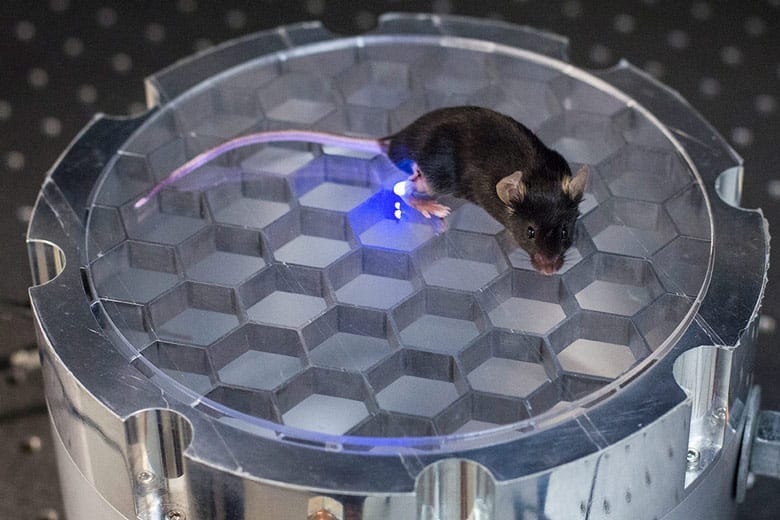
A blue glowing device the size of a peppercorn can activate neurons of the brain, spinal cord or limbs in mice and is powered wirelessly using the mouse’s own body to transfer energy. Developed by a Stanford Bio-X team, the device is the first to deliver optogenetic nerve stimulation in a fully implantable format.
A miniature device that combines optogenetics – using light to control the activity of the brain – with a newly developed technique for wirelessly powering implanted devices is the first fully internal method of delivering optogenetics.
The device dramatically expands the scope of research that can be carried out through optogenetics to include experiments involving mice in enclosed spaces or interacting freely with other animals. The work is published in the Aug. 17 edition of Nature Methods.
“This is a new way of delivering wireless power for optogenetics,” said Ada Poon, an assistant professor of electrical engineering at Stanford. “It’s much smaller and the mouse can move around during an experiment.”
The device can be assembled and reconfigured for different uses in a lab, and the design of the power source is publicly available. “I think other labs will be able to adapt this for their work,” Poon said.
Scaling down
Traditionally, optogenetics has required a fiber optic cable attached to a mouse’s head to deliver light and control nerves. With this somewhat restrictive headgear, mice can move in an open cage but can’t navigate an enclosed space or burrow into a pile of sleeping cage-mates the way an unencumbered mouse could. Also, before an experiment a scientist has to handle the mouse to attach the cable, stressing the mouse and possibly altering the outcome of the experiment.
These restrictions limit what can be learned through optogenetics. People have successfully investigated a range of scientific questions including how to relieve tremors in Parkinson’s disease, the function of neurons that convey pain and possible treatments for stroke. However, addressing issues with a social component like depression or anxiety or that involve mazes and other types of complex movement is more challenging when the mouse is tethered.
Poon had made a name for herself creating miniature, implantable, wirelessly powered devices. Although that capability was badly needed in the optogenetics world, Poon didn’t know it until she attended a neural engineering workshop that brought together faculty from neurosciences and engineering.
At that event Poon met Logan Grosenick, who was a graduate student from the lab of Karl Deisseroth, a Stanford professor of bioengineering and of psychiatry and behavioral sciences who invented optogenetics. But Grosenick didn’t have time to lead a collaboration.
Through follow-up conversations, Poon eventually met graduate student Kate Montgomery, who was working in the lab of Scott Delp, professor of bioengineering and of mechanical engineering, and collaborating with Deisseroth. “It was clear that this could provide a powerful tool for neuroscience. We just needed to prove it would work,” Delp said.
“Since then our labs have established a lasting scientific relationship,” said Montgomery, who has an interdisciplinary fellowship through Stanford Bio-X. She and graduate student Alexander Yeh, who worked in Poon’s lab, were co-first authors on the research paper.
Before a new wave of tinfoil hat designs takes over the Internet, it is important to clarify one point: Optogenetics only works on nerves that have been carefully prepared to contain the proteins that respond to light. In the lab, scientists either breed mice to contain those proteins in select groups of nerves or they carefully and painstakingly inject viruses carrying the protein DNA into nerves the size of dental floss. Shining a light – whether through a fiber optic cable or a wireless device – on neurons that haven’t been prepared has no effect.
Powering up
Poon said that developing the tiny device to deliver light was the easy part. She and her colleagues developed that and had it working a few months after the workshop. What was hard was figuring out how to power it over a large area without compromising power efficiency.
Read more: Stanford engineers develop a wireless, fully implantable device to stimulate nerves in mice
The Latest on: Delivering wireless power for optogenetics
[google_news title=”” keyword=”delivering wireless power for optogenetics” num_posts=”10″ blurb_length=”0″ show_thumb=”left”]
via Google News
The Latest on: Delivering wireless power for optogenetics
- WiBotic unveils new high power wireless charging solutionon May 1, 2024 at 2:21 am
WiBotic unveiled a new, larger 1kW charger, expanding its portfolio to provide wireless charging for larger battery systems.
- Restoring sight is possible now with optogeneticson April 23, 2024 at 3:30 am
Several companies are experimenting with optogenetics to create a “bionic eye” that can restore sight in visually impaired people.
via Bing News










